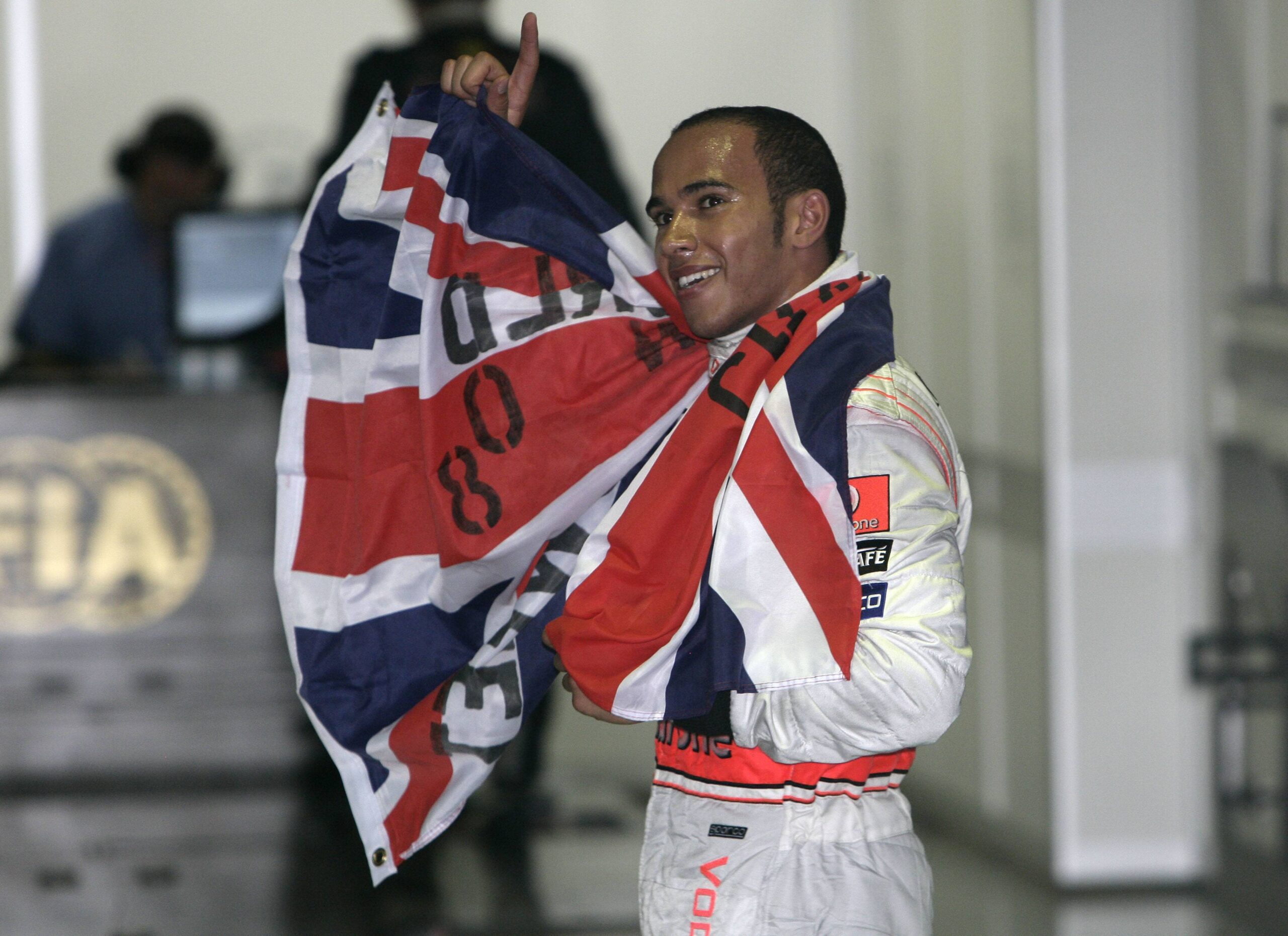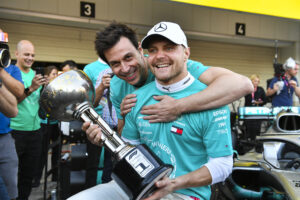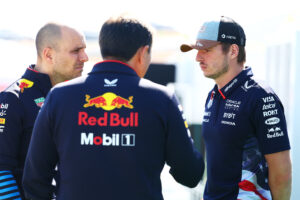Relive Lewis Hamilton’s 2008 F1 title win, where he became the then-youngest World Champion with a jaw-dropping final-lap drama in Brazil.
Seven Stars: Lewis Hamilton’s Legacy in Formula 1
As one chapter of Lewis Hamilton’s extraordinary career comes to a close, another is set to begin.
With his move to Ferrari in 2025, Hamilton leaves behind a legacy at Mercedes that redefined dominance in Formula 1. But before he embarks on this new journey, it’s the perfect time to reflect on the moments that made him a seven-time World Champion.
Over the next seven weeks, we’ll relive the defining seasons of Hamilton’s career, celebrating his unparalleled achievements and revisiting the path that established him as one of the greatest drivers in history.
2008: The Birth of a Champion
In 2008, Lewis Hamilton announced himself as a force to be reckoned with in Formula 1, securing his first World Drivers’ Championship in dramatic fashion.
Against the backdrop of redemption following the heartbreak of 2007, Hamilton etched his name into the history books at just the last moment in the season finale – Brazil.
It was the start of a journey that would lead to seven world titles, countless records, and an enduring legacy.
From triumph to turmoil
The season began brilliantly for Lewis Hamilton in Australia, where he dominated the race from pole to secure a lights-to-flag victory, as both Ferrari drivers retired. However, the Malaysian Grand Prix saw a setback when Hamilton dropped from P4 to P9 due to grid penalties, finishing P5 as Kimi Räikkönen took the win. Despite this, Hamilton held on to his lead in the Drivers’ Championship.
In Bahrain, Hamilton’s race took a turn for the worse. A poor start and a collision with Fernando Alonso left him to finish P13, while Ferrari secured a 1-2 finish, with Raikkonen taking the championship lead.
Back on track
The European season brought a positive shift. In Spain, Hamilton returned to the podium despite racial prejudice earlier in the year, finishing third behind the Ferraris.
He was on the podium again in Turkey, this time separating the Ferrari drivers.
Monaco, however, proved to be a race to remember.
Despite Ferrari locking out the front row, Hamilton made an early pass on Raikkonen, but a puncture after hitting a barrier dropped him to P5 when he pitted.
As the race conditions improved, Hamilton made up for his early mistake, gaining the lead and winning the Monaco Grand Prix in a performance reminiscent of Ayrton Senna’s iconic Monaco drives.
READ MORE: Lewis Hamilton Bites Back at ‘Shelf Life’ Comments
Misfortune strikes
The Canadian Grand Prix, a track where Hamilton claimed his maiden F1 victory, was expected to be another triumph. Starting from pole, he looked untouchable – until disaster struck.
A pit-lane error under the safety car saw him collide with Kimi Räikkönen, forcing both to retire. It was a costly mistake in a tightly fought championship.
In France, penalties from the Canadian incident carried over, relegating Hamilton to 13th on the grid.
Despite a determined effort to climb back, further penalties saw him finish outside the points in 10th, a stark reminder of how quickly fortunes can change in Formula 1.
The first of nine
At the end of lap 60, Lewis Hamilton crossed the line to become a British Grand Prix winner for the first time in his career. 16 years later, Hamilton has now won at his home Grand Prix a record 9 times.
In his second home Grand Prix, Hamilton qualified P4, his McLaren teammate Heikki Kovalainen in pole. Hamilton made a strong start, passing Kovalainen by Lap 5 and pulling a 6-second lead by Lap 10, with Raikkonen close behind.
A pivotal moment came when McLaren refuelled and changed Hamilton’s tyres during a pit stop on Lap 21, while Ferrari only refuelled Raikkonen. As the rain returned, Ferrari’s gamble backfired, and Hamilton’s team made the right call.
Hamilton dominated the wet conditions, avoiding mistakes as others spun off, and took his first British Grand Prix victory. He would go on to win a record nine times at Silverstone.
Conquering Germany
Lewis Hamilton’s 2008 title win was not won with ease. As seen in some of the previous rounds, there were some setbacks. And more would soon follow.
But first, was a triumph in Germany. At the Hockenheimring circuit, Hamilton started on pole. On Lap 50, he made a late pit stop, dropping to fifth. But by Lap 60, he regained the lead, which he maintained until the chequered flag.
That marked two wins in a row for the McLaren driver and his fourth of the season. At that point in the season, no one had won more races than him. It also propelled him back to the top of the Drivers’ Championship standings.
His glory run hit a roadblock in the next round. He finished the Hungarian Grand Prix in P5, despite starting in pole. With Massa passing him at the first corner and a punctured tyre hampering his race, that was a weekend to forget for Hamilton.
His next weekend was rather uneventful, It was at Valencia, the European Grand Prix where he crossed the line in P2, right where he started.
Victory lost in controversy
Hamilton crossed the line first at the Belgian Grand Prix, but his victory was overturned by the Stewards. After a spin on Lap 2, Hamilton fought back, eventually overtaking Raikkonen, who regained the lead before Hamilton reclaimed it.
As the rain intensified, Raikkonen spun and crashed, handing Hamilton the lead again, but a 25-second penalty was issued for gaining an unfair advantage when he cut the Bus Stop chicane whilst attempting to overtake the Finn earlier on. This dropped him to third, behind Nick Heidfeld and Felipe Massa, who inherited the win.
The stewards argued that Hamilton did not sufficiently yield the advantage gained by cutting the chicane. Although he let Raikkonen retake the lead, his immediate overtake at La Source was deemed to have exploited the momentum he carried from the earlier incident.
The decision sparked significant backlash.
McLaren argued that Hamilton had adhered to the rules by yielding the position and that the subsequent overtake was legitimate.
Fans and analysts debated whether the penalty was consistent with previous incidents and whether it unfairly influenced the championship.
Crashgate Scandal
After a disappointing P7 finish on a wet weekend at the Italian Grand Prix where Sebastian Vettel claimed his maiden F1 win, Hamilton fought his way back to the podium at the first-ever night race in the sport’s history.
The McLaren driver started the race in P2 and finished on the final step of the podium. Massa failed to score points that night, further extending Hamilton and McLaren’s advantage in the Drivers’ and Constructors’ Championships.
The 2008 Singapore Grand Prix, later marred by the Crashgate scandal, played a critical role in Lewis Hamilton’s 2008 title campaign. While Renault’s deliberate actions benefited Fernando Alonso, Hamilton capitalized on the ensuing chaos to secure third place, gaining crucial points.
In contrast, Felipe Massa’s disastrous pit stop dropped him out of the points, significantly boosting Hamilton’s championship lead.
YOU MAY ALSO LIKE: Viva Las Vegas! Russell Wins an Exciting Las Vegas GP, as a World Champion Is Crowned
Pressure builds in Asia
In the 2008 Japanese Grand Prix, Hamilton faced a challenging race.
He was involved in a first-lap incident with Kimi Raikkonen and Heikki Kovalainen, which sent all three drivers down the order. On Lap 2, Hamilton was spun around by a collision with Felipe Massa. He had to make a pit stop, which dropped him to 18th place.
A subsequent drive-through penalty for forcing Raikkonen off track further hampered his race. Hamilton crossed the finish line in P12. As Massa was in P7, his two points closed the gap to Hamilton by 5 points in the Drivers’ standings.
In China, Hamilton took his seventh and final pole position of the season by three-tenths of a second.
He maintained control from pole position, initially leading the race despite pressure from Kimi Raikkonen. He had a strong first stint, setting fastest lap after fastest lap. Hamilton’s pace remained consistent throughout the race, even as Ferrari’s Massa and Raikkonen tried to close the gap.
Hamilton went on to win his fifth and final win of the season, with Massa and Raikkonen in P2 and P3 respectively. The win in China gave Hamilton a 7-point lead in the Drivers’ standings heading into the final race of the season.
The final lap
The 2008 Formula 1 season delivered one of the most nail-biting finales in the sport’s history. Hamilton entered the Brazilian Grand Prix with a 7-point lead. He only needed a fifth-place finish to secure the championship if Felipe Massa won the race.
Massa started from pole while Hamilton started fourth. Light rain at the start of the race brought chaos, but both drivers navigated through unscathed.
As the race progressed, a second shower of rain in the closing laps threw everything into turmoil. With nine laps to go, Hamilton held fifth, with Sebastian Vettel in a Toro Rosso pressuring him from behind.
The situation became dire when Robert Kubica’s BMW, unlapping itself, caused Hamilton to run wide. This allowed Vettel to slip through into fifth. With three laps remaining, Hamilton desperately pursued Vettel to reclaim the critical position.
Meanwhile, ahead of the battling pair, Timo Glock in the Toyota, still on dry-weather tyres, began to struggle as the rain intensified.
Massa crossed the line first, and for a few fleeting moments, Ferrari believed he had claimed the title. But in the final corners of the final lap, Hamilton and Vettel overtook Glock’s slowing car, with Hamilton reclaiming fifth.
In an unforgettable twist, Martin Brundle’s iconic commentary – “Is that Glock?” – captured the moment Hamilton secured his maiden Drivers’ Championship by a single point.
The emotional rollercoaster was unprecedented. Massa’s joy turned to heartbreak, while Hamilton’s team erupted in jubilation.
Against all odds, the 23-year-old became Formula 1’s youngest world champion, rewriting history in a way only sport can deliver.
READ NEXT: Valtteri Bottas Set for Mercedes Return as Reserve Driver






